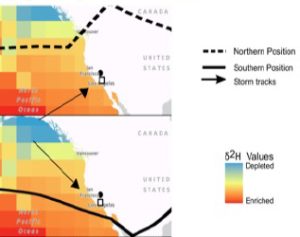
Tracking the Jet Stream with Plant Wax Biomarkers in Sierra Nevada, California
Meghan Spoth, Climate Change Institute, University of Maine, Orono, ME
Cincinnati & Amherst Laboratory Visits:
University of Cincinnati – Organic Geochemistry Laboratory – May 2022
University of Massachusetts at Amherst – Ronald B. Gilmore X-Ray Fluorescence Laboratory – July 2022
Funding Support: The Robert & Judith Sturgis Family Foundation, Geological Society of America Graduate Student Grant, and the UMaine Graduate School
The Baboon Lakes of the central Sierra Nevada have sediment records spanning the last 13,000 years. Through the funding of the 2022 Bob and Judy Sturgis Exploration Fund Opportunity, I sampled this sediment core for plant wax biomarkers at the University of Cincinnati to understand the relationship between changes in water availability and the migrations of the Jet Stream over this long time scale and process the core for XRF at the University of Massachusetts at Amherst.. Plant wax biomarkers provide data on the unique isotopic composition of storm tracks to the site, water availability, and the relative evaporation rate. This provides insight on past drought periods with its relationship to the migration of the Jet Stream and its storm tracks over time. XRF measures elemental composition linked to wind patterns and drought conditions.
Preliminary Results:
My preliminary results so far indicate definitive shifts in the local climate of these lakes throughout the record. There is an overall increase in productivity ~6,000 years ago during the Mid-Holocene Thermal Maximum. The final results of the plant wax biomarkers this fall will provide a broader picture to understand the role of the Jet Stream in this past warm period and inform modern climate models to predict the severity and length of potential future droughts.
Funding Acknowledgement:
I would like to thank the Sturgis Exploration Fund, the Geological Society of America Graduate Student Grant, and the UMaine Graduate School for sponsoring this research. Thank you to Dr. Aaron Diefendorf at the University of Cincinnati and Dr. Rhodes at UMass Amherst for guiding use of the labs.



